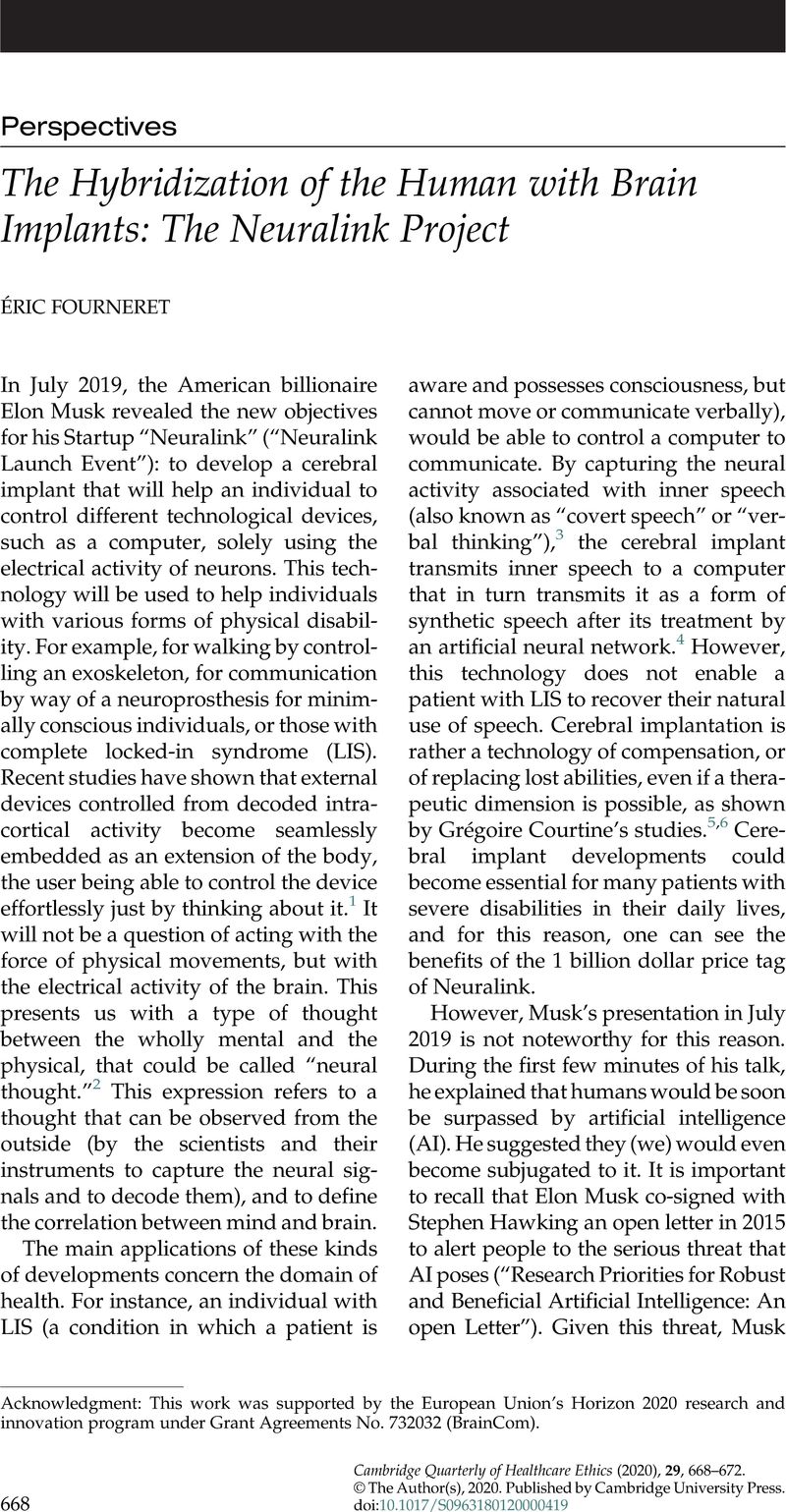Article contents
The Hybridization of the Human with Brain Implants: The Neuralink Project
Published online by Cambridge University Press: 07 September 2020
Abstract

- Type
- Perspectives
- Information
- Cambridge Quarterly of Healthcare Ethics , Volume 29 , Special Issue 4: Clinical Neuroethics , October 2020 , pp. 668 - 672
- Copyright
- © The Author(s), 2020. Published by Cambridge University Press
Footnotes
Acknowledgment: This work was supported by the European Union’s Horizon 2020 research and innovation program under Grant Agreements No. 732032 (BrainCom).
References
Notes
1. Collinger, JL, Wodlinger, B, Downey, JE, Wang, W, Tyler-Kabara, EC, Weber, DJ, et al. High-performance neuroprosthetic control by an individual with tetraplegia. The Lancet 2013;381(9866):557–64.CrossRefGoogle ScholarPubMed
2. Hocquet T, . Cyborg Philosophie: Penser Contre Les Dualismes. L’ordre Philosophique. Paris, France: Seuil; 2011, at 368.Google Scholar
3. Alderson-Day, B, Fernyhough, C. Inner speech: Development, cognitive functions, pheno-menology, and neurobiology. Psychological Bulletin 2015;141(5):931–65.Google Scholar
4. Rainey, S, Maslen, H, Mégevand, P, Arnal, LH, Fourneret, E, Yvert, B. Neuroprosthetic speech: The ethical significance of accuracy, control and pragmatics. Cambridge Quarterly of Health Care Ethics 2019;28(4):657–70.CrossRefGoogle ScholarPubMed
5. Courtine, G, Sofroniew, MV. Spinal cord repair: Advances in biology and technology. Nature Medicine 2019;25(6):898–908.CrossRefGoogle ScholarPubMed
6. Courtine, G, Micera, S, DiGiovanna, J, Millán, JDR. Brain-machine interface: Closer to therapeutic reality? The Lancet 2013;381(9866):515–7.CrossRefGoogle ScholarPubMed
7. Hottois, G. La Science Entre Valeurs Modernes et Post-Modernité. Paris, France: Vrin; 2005.Google Scholar
8. Resnik, DB. Ethics of science. In: Curd, M, Psillos, S, eds. The Routledge Companion to Philosophy of Science. London, UK: Routledge; 2015.Google Scholar
9. Harris, JP, Tyler, DJ. Biological, mechanical, and technological considerations affecting the longevity of intracortical electrode recordings. Critical Reviews in Biomedical Engineering 2013;41(6):435–56.Google ScholarPubMed
10. Ferraris, M. Manifiesto del Nuevo Realismo. Beri, Italy: SEDIT; 2012.CrossRefGoogle Scholar
11. Searle, JR. (1980) Minds, brains, and programs. Behavioral and Brain Sciences 3 (3): 417–457 CrossRefGoogle Scholar
12. Latour, B. Ramsès II est-il mort de la tuberculose? Recherche 1998;307 (30):225–248.Google Scholar
13. Latour, B. Why has critique run out of steam? From matters of fact to matters of concern. Critical Inquiry 2004;307:84–85.Google Scholar
14. Mayne, AJ, Collingridge, D. The social control of technology. Journal of the Operational Research Society 1982.CrossRefGoogle Scholar
15. Xavier G, . Philosophie des Nanotechnologies. Paris, France: Hermann; 2014, at 342.Google Scholar
16. Larousserie D, . Le blues des chercheurs français. Le Monde.fr [Internet]. available at https://www.lemonde.fr/sciences/article/2019/10/14/le-blues-des-chercheurs-francais_6015488_1650684.html (last accessed 18 Oct 2019; published 14 Oct 2019).Google Scholar
17. Nussbaum, MC. Not for profit: Why democracy needs the humanities. The European Legacy 2012;17(1):104–5.Google Scholar
- 12
- Cited by




